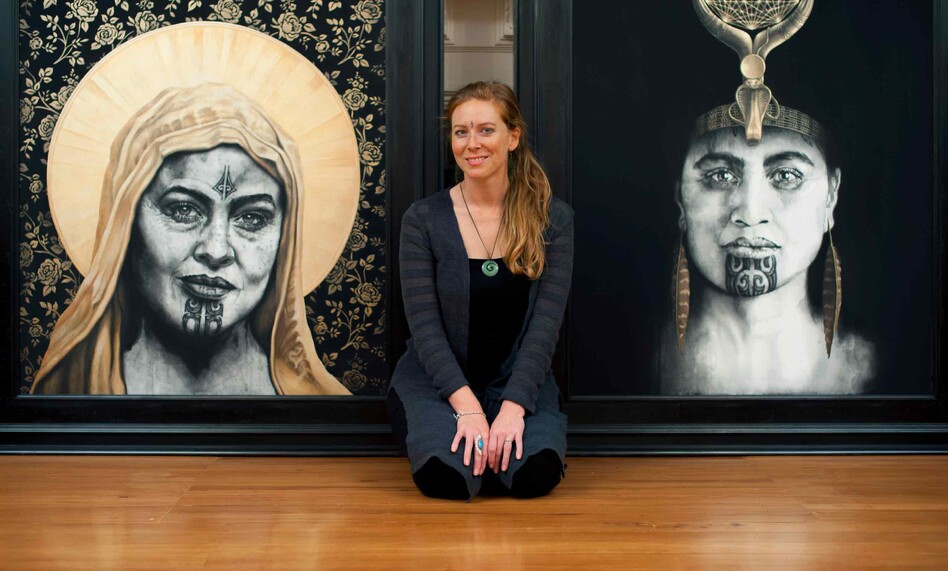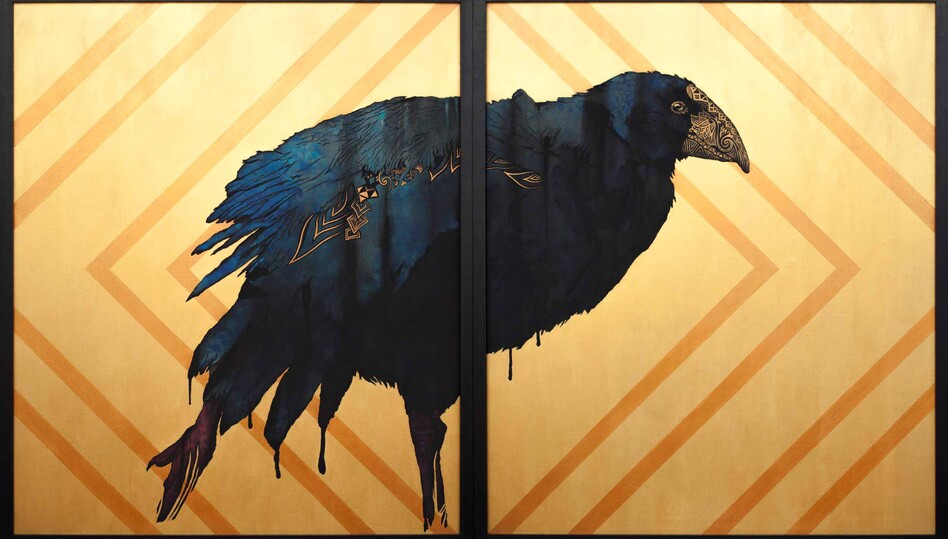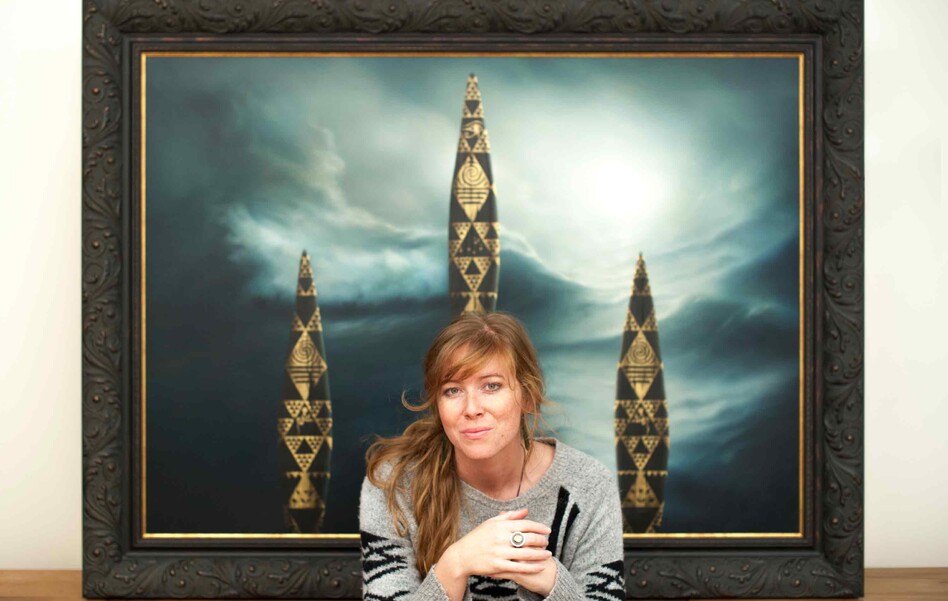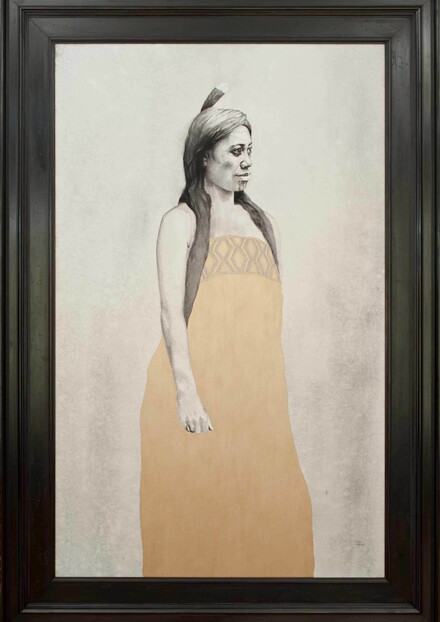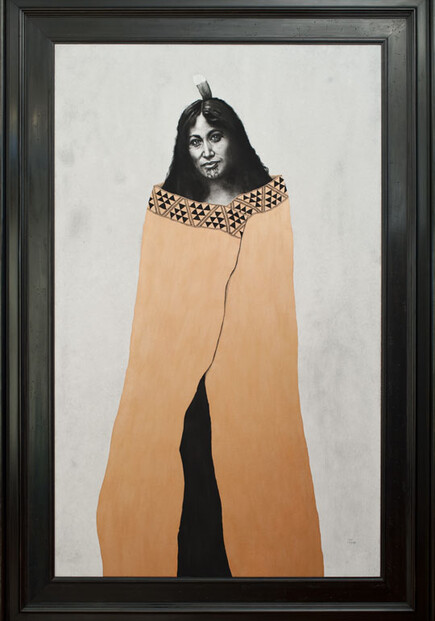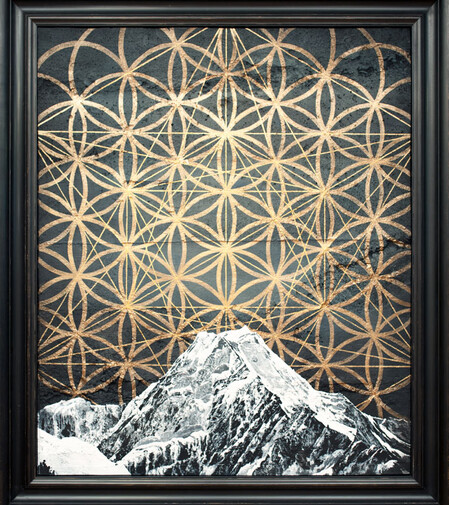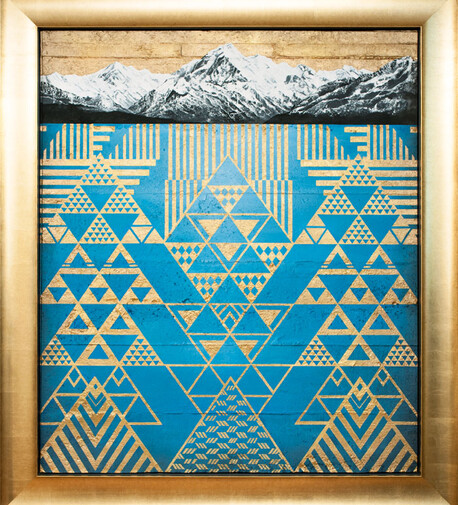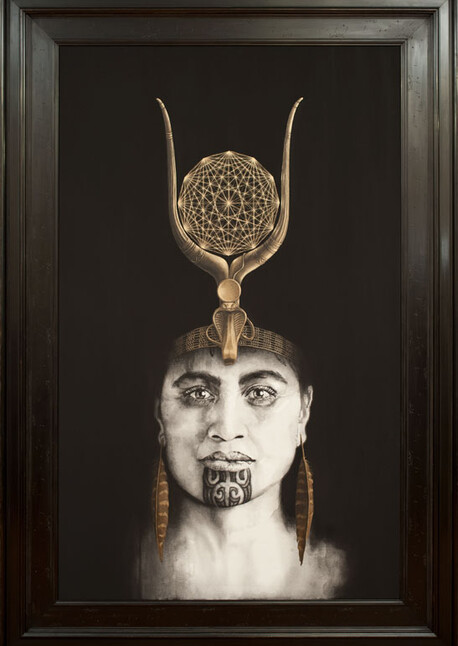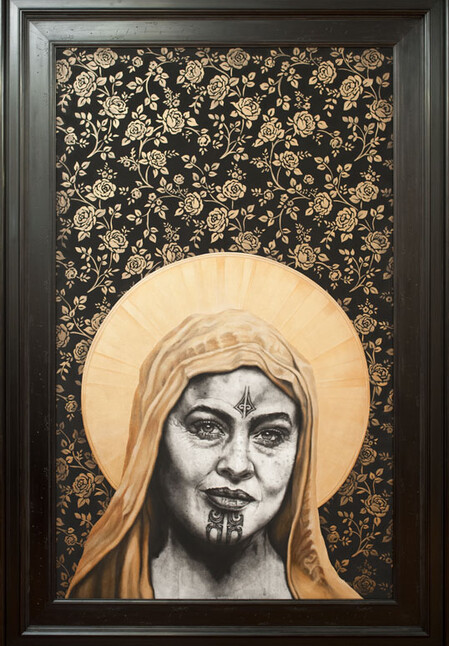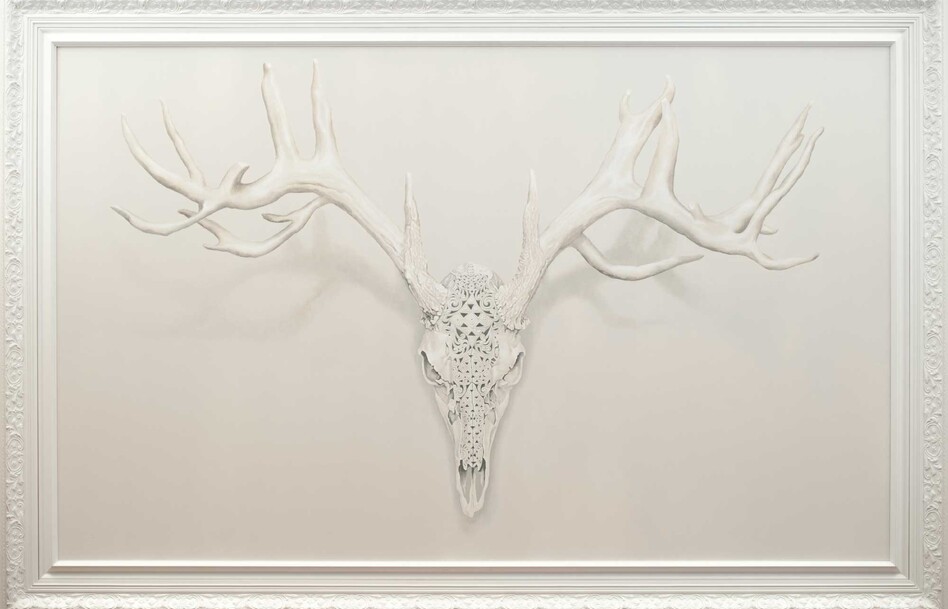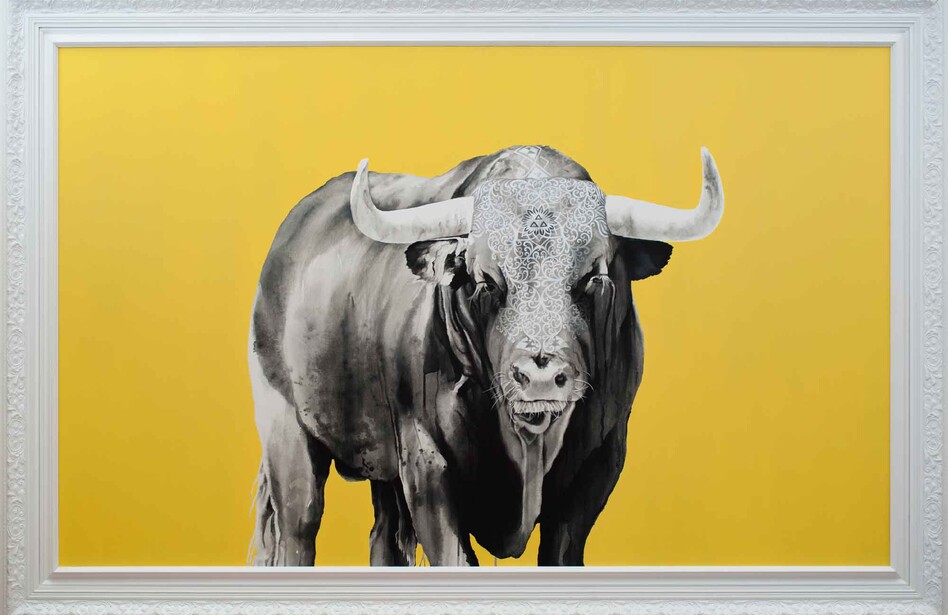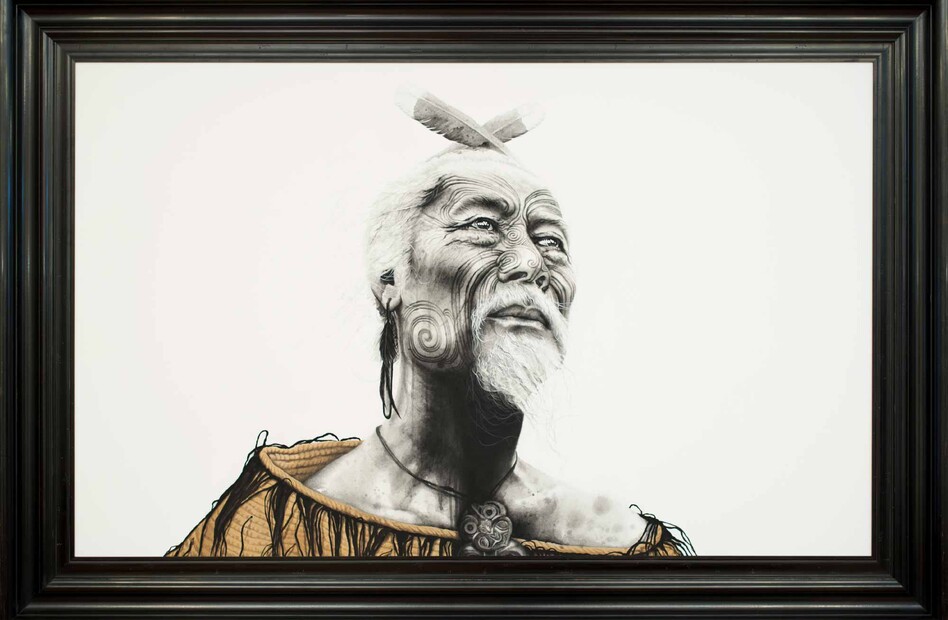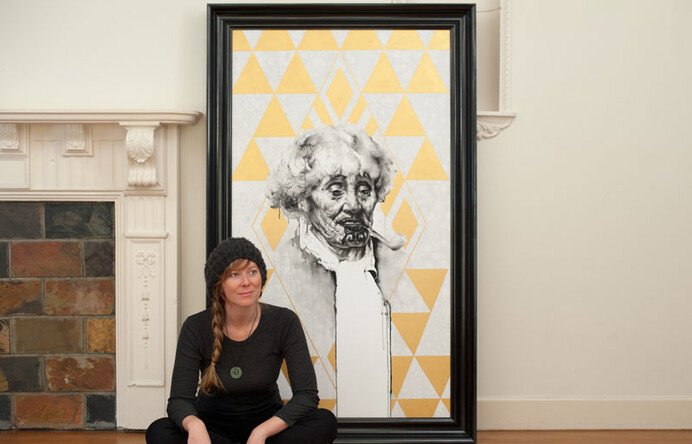Sacred Mirrors Art Exhibition
Sacred Mirrors is a way for people to approach these paintings. Minson hopes that “we see qualities in our own nature reflecting back to us.”
This series of works was exhibited June 2017 at Parnell Gallery in Auckland, NZ
Maori portraits with facial moko.
Wild oceans and mountainous New Zealand landscapes.
Animals decorated with sacred geometry.
All artworks in this series bear the names of ancestors and mythological deities from Māori, Egyptian, Hindu and Christian cosmology.
The Auckland based painter whose art has been collected all over the world for 13 years is of Ngāti Porou, Swedish, English and Irish heritage.
Sofia grew up in New Zealand, Samoa, Sri Lanka and China due to her father’s engineering project management work. She became interested in the connections between diverse people, cultures and religions.
On returning home to New Zealand, it was painting the myths, land and people of Aotearoa that helped strengthen her link to her Maori roots.
Minson’s large contemporary paintings are charged with ancient symbols and images of gods and goddesses.
There are several female portraits.
A thread of Mana Wāhine or The Divine Feminine runs through them.
The women embody qualities of the guardian of the underworld Hine-nui-te-pō, the Egyptian goddess Isis, mother Mary in Christian theology and a Ngāpuhi princess who was painted by C.F. Goldie over a century ago.
A dozen white canvases have given way to months of the artist’s watery washes of black ink-like paint, rendering delicate images of nature and soulful faces, crowned with highlights of shining, metallic gold.
Their emotion is transmitted through powerful, singular, focussed compositions that demand your attention.
In the five years since her last major solo exhibition, Minson has been gathering inspiration and evolving a new painting style. She believes "cultivating playfulness and non-judgement about art-making is essential for creativity."
In this fast paced digital world Sofia says painting these awe-inspiring characters was "both grounding and uplifting." She hopes they can provide a sense of connection for other people as well.
One of the artist's favourite quotes, which inspired the title of the exhibition is from Khalil Gibran:
“Beauty is eternity gazing at itself in a mirror.
But you are eternity and you are the mirror.”
Exhibition Information
Sacred Mirrors Art Exhibition by Sofia Minson
13 - 27 June 2017 Parnell Gallery, Auckland
Opening Tues 13th June 5:30pm
“Sacred Mirrors” is Sofia Minson's exhibition of new works at Parnell Gallery.
It's her first solo show in five years so she'd love to have your support.
Opening night is free and all are welcome so come and join us at 5:30pm on Tuesday 13th June 2017 to celebrate!
The works will be on display until 27 June 2017 at Parnell Gallery, Auckland.
Media Kit - Q&A with Sofia Minson Artist
How and why did you become an artist?
I never decided to be an artist, I was always painting, drawing and creating since I can remember.
There are drawings my mum has kept from when I was two years old. A lot of kids are like this, the only difference is I never stopped.
It’s now my lifestyle and career and the term “artist” has become useful in the “game of life.” But in truth, I make art whether I’m paid for it or not.
What inspires your work?
I’m interested in my mixed Ngati Porou Maori, Swedish, English and Irish bloodline and I’m inspired by the taonga (treasure) of Aotearoa’s people, land, forests and birds.
I spent a lot of my childhood in Samoa, Sri Lanka and China due to my father’s civil engineering work.
Now I paint from my Auckland studio – mostly contemporary portraits, landscapes and images of nature, which contain patterns from ancient cultures that celebrate connections between diverse peoples.
Who are your influences?
When painting Maori portraits I look to 19th and 20th century C.F. Goldie and Gottfried Lindauer portraits and old black and white photographs of Maori. There’s a dignified, romantic, historical aesthetic from those portraits that I like to bring through in my own contemporary style.
Leading up to a show like this I’m in the studio hour after hour, day after day, for months on end, so my inspiration for ideas largely comes through audiobooks and podcasts that I find fascinating. Often they’re about ancient civilizations, human nature, cosmology, or just plain entertaining.
I love listening to comedians’ podcasts like the Joe Rogan Experience because there’s a healthy dose of irreverence with an undercurrent of actual curiosity about the world. Or maybe it's because they're just as crazy as I am.
During the making of this series of works I was listening to a lot of comedian and psychonaut Duncan Trussell. He’s so creative with words and ideas and is always asking “what is the nature of reality?” and “how can I live a more loving life?” The topics he brings up around religion, science, technology and mysticism has been a massive inspiration for further areas of inquiry for me and has definitely influenced this exhibition.
Sometimes I turn to mystical poets like Khalil Gibran and Rumi or ancient esoteric texts like the Tao Te Ching and the hermetic Emerald Tablets to get my mind blown and heart broken open.
There’s also been a dose of Professor Jordan Peterson, Sharon Salzberg, Ram Dass, Alan Watts and Wayne Dyer in there too.
And the list goes on. Podcasts and audiobooks are my lifeblood while I’m painting!
Can you talk about your process?
These pieces all started life as the most incredible gift an artist could get - a blank white canvas. When I reveal a canvas from its cardboard packaging, I stare at the white space and imagine all the possibilities.
I might lightly map out a composition or just start sploshing layers of watery washes of black ink-like paint called flashe. Their forms take shape over many weeks - faces, landscapes, animals and birds appear. And then finally I use the shining, metallic gold paint to highlight the images with halos, crowns, garments like korowai (cloaks) and detailed sacred geometric patterns.
My ideas and techniques have evolved over the last 13 years since I entered into the professional art world. For the first decade I was painting close-up faces, nudes, New Zealand landscapes and seascapes with waka, and obsessively honing a moody, glowing oil painting technique.
For the last couple of years I’ve been playing around with water-based paints and and highly detailed patterns and symbols from Pacific and Asian cultures.
It can take anywhere from a couple of weeks to three years to complete a painting. I usually have three or more pieces on the go at one time and on a daily basis I go where the inspiration leads me.
Can you tell me about this series of work?
These are large, bold paintings that give you nowhere else to look. They confront you and then draw you in with intricate detail.
Each painting is a self portrait. While I’m painting, I’m embodying the feeling, the characters and the traits of the spirit of the piece onto the canvas. I’m getting my ego out of the way and letting the message come through. You could call it channeling. It might sound lofty but I think it’s how all creativity happens.
I was racking my brain, trying to figure out the link between these artworks so I could describe this exhibition to people and give the show a title. I finally saw it staring me in the face - every single painting, whether it was a landscape, portrait or animal, had the name of an ancestor or deity. The link was so obvious! But it must have been subconscious.
Each painting embodies symbols and emotive qualities of various gods and goddesses from Maori, Egyptian, Hindu and Christian cosmology.
They are dense with myths and cultural symbols that might trigger our mystical or emotional connections on an unconscious level, which is where the power of symbols really lie. Visual symbols have a talent for bypassing our conscious mind of objections and control, and speaking directly to our subconscious mind.
One of your themes is “Transcending Culture,” what do you mean by this?
Culture and religion are dead things unless they’re animated by people. I’ve used Maori, Egyptian, Christian and Hindu ideas as a visual language or tool to investigate higher truths. When we transcend culture we are all connected.
“Out beyond ideas of wrongdoing and rightdoing,
there is a field. I'll meet you there.
When the soul lies down in that grass,
the world is too full to talk about.
Ideas, language, even the phrase "each other" doesn't make any sense.”
- Mevlana Jelaluddin Rumi - 13th century Sufi mystic
Institutions like culture, governments and religion tend to be behemoths with strict rules and tapu, which are slow to change with the times. Tapu and sacredness are helpful to give us a sense of respect for the power of a thing, but I think it is important to free ourselves up once in awhile and move past the rules and the boundaries that we’ve inherited from previous generations.
It's a balancing act between tradition and evolution. It's the curved female and direct straight line male aspects existing together. It is important to listen to our hearts, not just to follow rules and cultural norms. But, there's a difference between listening to our hearts and obeying destructive voices in our heads.
What does “Sacred Mirrors” mean?
The whole world is a sacred mirror.
One of my favourite quotes is from Khalil Gibran, author of The Prophet. I have it pasted up on my wall: “Beauty is eternity gazing at itself in a mirror. But you are eternity and you are the mirror.”
There are many levels in which we enjoy art so I'm not a big fan of being didactic to viewers. But on an emotional or spiritual level, when we look into a painting I think it can reflect back to us an energy that we already have inside, and can be a way of accessing different states of consciousness.
I’ve named the exhibition Sacred Mirrors to help people get into a frame of mind where they can experience the art as a reflection of themselves.
I think we’re capable of every single trait in the universe, light and dark. So as an artist, if something profound or loving for example, is coming through me then I must admit, those qualities exist in me. In the same way as a viewer, as someone who appreciates art, by recognising uplifting qualities or beauty in a piece of work, it is coming through you too and is a part of you.
We all know how this feels with music, when we are moved by a song or our heart breaks over some lyrics. That is compassion and we have potential for all those emotions within ourselves, all the time.
Why did you start painting Maori portraits?
The first Maori portrait I created was in 2006 of my own Ngati Porou great grandmother Matire Te Horowai. It gave me a sense of her ancestral presence, it filled me with wairua, and my interest in portraying our tupuna has evolved from then on.
19th and 20th century C.F. Goldie and Gottfried Lindauer portraits of Maori inspired me to re-create that old romanticism and mana (dignity), which seems nourishing for the soul in this modern, digital, face-paced world.
These artworks redirect the ‘gaze’ of indigenous portraiture. Rather than European colonial painters and audiences gazing upon Maori subjects, as a Ngati Porou artist I am depicting fellow contemporary Maori people. The gaze is between Maori and out of the canvas to the rest of the world.
Can you tell us about the Maori portraits in this exhibition? Are they of actual people?
The portraits in this exhibition are imagined Maori figures embodying larger, mythological ideas and qualities of gods and goddesses.
They aren’t historic or living people. Their faces are formed from composites in my imagination, based on hundreds of 19th and 20th century black and white photos and paintings of Maori that I’ve seen over the years.
The Maori faces and symbols help get me into a sacred space. Using the aesthetics of our ancestors with ideas from indigenous cosmology, I’m able to connect with something much older, more vast and definitely wiser than myself.
There is an emphasis on Mana Wāhine or The Divine Feminine in several of the Maori female portraits of goddesses. We are experiencing a time in our modern culture where we need more of this Mana Wāhine in each and every one of us. The portraits embody slightly different qualities but all seem strong, fair and unconditionally loving.
What does your art practice mean to you?
I paint every day. I learn every day. My art is my university!
Art is a process of gathering learnings from life experiences, travel, audiobooks, podcasts and video and filtering it through a creative portal.
The Buddhists have a term “the fundamental dissatisfaction of life” which, unless we’re enlightened, we know as that feeling of finally getting what we want, and then immediately wanting something else. There is an underlying suffering or low-level itchiness in life. So, in the midst of that turmoil when I am working on myself, I try to learn, stay open minded, open my heart and be as authentic as I can.
I draw inspiration from many different cultures and religions that I’ve been exposed to over the years to create my art. Culture is a useful tool, it is a language, but what I’m really interested in is transcending culture to unify people.
When I’m actually painting I’m not too worried about the intellectual reason for the artwork. I try and ignore those little voices in my head containing other people’s judgement. I try to come back to innocence, playfulness and enjoying the moment in the studio. I call it playing because art-making doesn’t have to be so serious. This is my authentic self and it is in that creative zone that messages come through without me even knowing.
Are there times when you become blocked creatively? How do you become re-inspired?
Yes absolutely! I’ve had periods of painter’s block that have lasted for months on end and I’ve become very depressed.
I’m usually blocked because I’m taking life too seriously and trying to force production. The worst is when I get into the mind trap of creating art for money or to please some external authority figure, whether real or imagined. It becomes toxic and my creativity dries up, so that type of thinking never works for me. But those struggles have taught me how I work best.
I’m happiest when I’ve distanced myself from voices in my head that care about what other people think. I become re-inspired when I’m playing in the studio, staying innocent, and listening to fascinating audiobooks, podcasts and music. Travelling i.e. changing my environment is also helpful in getting perspective on my life. I then remember that painting is just an enjoyable tool, it's a therapy for me at its best, and it’s meant to be fun!
Why did you decide to have this exhibition?
2012 was my last big solo show and it was a really good five year break from that format. It has enabled me to re-discover who I am as an artist.
During that hiatus I was releasing works gradually as they were produced, which is very different from putting together a solo exhibition like this and inviting everyone to come and see them as one event.
There are infinite possibilities of how to make and share art. You can find pioneering and innovative ways, and you don’t have to follow the norm.
The benefit of having a traditional solo exhibition in a gallery, is that the audience gets to experience a larger body of work presented all at once. They can observe themes being fleshed out more fully as they run through all the different pieces. So that definitely works for this series of paintings.
Sofia Minson Paintings | New Zealand Artwork
Stay in the loop
Find out first when Sofia's new original paintings are released.
And receive invites to important exhibitions.
